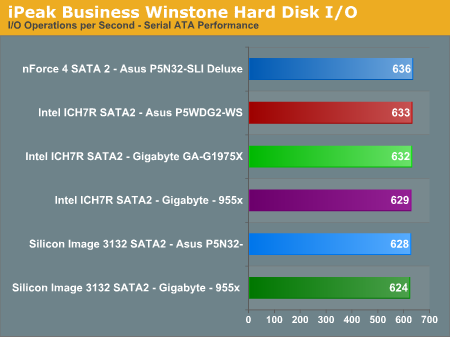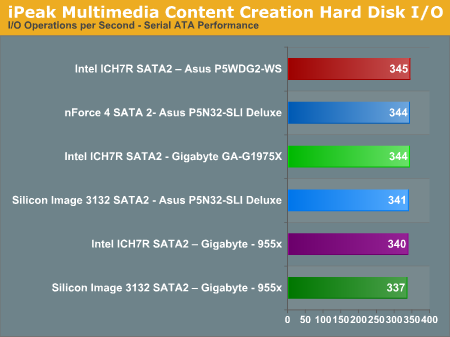Asus P5WDG2-WS: Intel 975X goes to Work
by Gary Key on December 6, 2005 12:05 AM EST- Posted in
- Motherboards
Disk Controller Performance
With the variety of disk drive benchmarks available, we needed a means of comparing the true performance of the wide selection of controllers. The logical choice was Anand's storage benchmark first described in Q2 2004 Desktop Hard Drive Comparison: WD Raptor vs. the World. The iPeak test was designed to measure "pure" hard disk performance, and in this case, we kept the hard drive as consistent as possible while varying the hard drive controller. The idea is to measure the performance of a hard drive controller with a consistent hard drive.
We played back Anand's raw files that recorded I/O operations when running a real world benchmark - the entire Winstone 2004 suite. Intel's iPEAK utility was then used to play back the trace file of all IO operations that took place during a single run of Business Winstone 2004 and MCC Winstone 2004. To try to isolate performance differences to the controllers that we were testing, we used the Maxtor MaXLine III 7L300S0 300GB 7200 RPM SATA drive in all tests . The drive was formatted before each test run and a composite average of 5 tests on each controller interface was tabulated in order to ensure consistency in the benchmark.
iPeak gives a mean service time in milliseconds; in other words, the average time that each drive took to fulfill each IO operation. In order to make the data more understandable, we report the scores as an average number of IO operations per second so that higher scores translate into better performance. This number is meaningless as far as hard disk performance is concerned as it is just the number of IO operations completed in a second. However, the scores are useful for comparing "pure" performance of the storage controllers in this case.
With the variety of disk drive benchmarks available, we needed a means of comparing the true performance of the wide selection of controllers. The logical choice was Anand's storage benchmark first described in Q2 2004 Desktop Hard Drive Comparison: WD Raptor vs. the World. The iPeak test was designed to measure "pure" hard disk performance, and in this case, we kept the hard drive as consistent as possible while varying the hard drive controller. The idea is to measure the performance of a hard drive controller with a consistent hard drive.
We played back Anand's raw files that recorded I/O operations when running a real world benchmark - the entire Winstone 2004 suite. Intel's iPEAK utility was then used to play back the trace file of all IO operations that took place during a single run of Business Winstone 2004 and MCC Winstone 2004. To try to isolate performance differences to the controllers that we were testing, we used the Maxtor MaXLine III 7L300S0 300GB 7200 RPM SATA drive in all tests . The drive was formatted before each test run and a composite average of 5 tests on each controller interface was tabulated in order to ensure consistency in the benchmark.
iPeak gives a mean service time in milliseconds; in other words, the average time that each drive took to fulfill each IO operation. In order to make the data more understandable, we report the scores as an average number of IO operations per second so that higher scores translate into better performance. This number is meaningless as far as hard disk performance is concerned as it is just the number of IO operations completed in a second. However, the scores are useful for comparing "pure" performance of the storage controllers in this case.












31 Comments
View All Comments
Pirks - Wednesday, December 7, 2005 - link
So data centers are built with floppies, COM mice and LPT printers. Great! Very nice that I don't run one, thank you for enlightening me.
FYI I've got ABIT AT7 mobo (the _ONLY_ legacy free mobo ever created) very cheap a couple of years ago and it was running all my 4-5 year old hardware like cheap USB kbd and old second hand USB mouse. And I still DON'T even consider wasting my money on Athlon 64 or any fancy PCIe stuff, and with all this I still sound Bleeding Edge Hardware Freak for you? Are you from a PC museum or what? Can you even find COM mice these days? I'm not buying anything that's above lower 30% of price range, so I won't even consider mainstream stuff these days. You seriously overestimate my financial abilities and more important my will to upgrade (I won't fix my PC unless it's broken)
XP SP2 here :P
I'd do that by patching my XP install CD or by using USB floppy (if it works, not sure about this), or if it doesn't work I'd replace my boot HDD with PATA one, given that it's not any slower than SATA these days :P So floppy is still not necessary WHILE every mobo out there includes PATA, and please note that I didn't include PATA in my Stupid Obsolete Interfaces list :) PATA is obsolete, yes, but it's still widely used everywhere (in almost every DVD burner, jeez, that's what I call LONGEVITY!) unlike LPT and COM and floppy and other museum stuff.
I'd say stick those LPT plugs onto the cheap "business" mobos, but please let us breathe fresher air with the "advanced", overclocker or whatever you call 'em mobos. There is a place for the old mobos with legacy stuff, but including them on those ubercool silver/gold advanced P4 975X or nForce4 SLI Ultra Extra boards? Do you seriously think the guy with dual 7800GTX setup uses COM mouse, LPT printer and other "data center" accessories? Hahahahahaaaa
Never tried that. I only run XP SP2 and never ever run into issues with its bootloader and my USB kbd, maybe 98/95 one has issues, dunno. Anyway, if you still use 95/98 then ok, you need COM and LPT as well.
It would be hard to persuade me someone still uses COM mice, their mechanics must be ground into dust by now :) And even if there are some ancient PDAs that don't have USB 1.x then there are USB-COM adapters, so COM is not needed too (btw there are USB-LPT adapters as well, for your data centers :P)
New computers are only 5% of the market? All these Dells, Compacs, HPs and many more, they are only 5%? OK, so 95% of the market are what? Retrofitted IBM PC XTs? Hahahahaaa...
Man you have no idea about my budget, really really! I run ABIT KW7, and looks like Socket A is my choice for at least 12 months from now if not more, depending on how things will turn out with Vista. You wanna know my top list of mobos I'd buy right now if I had the money? Number one - Chaintech S1689, dirt cheap 939 mobo, only 50 bucks or so, just stick cheapest Venice 3000 in there and fly away. Number two - ABIT AN8-V. Expensive bad boy, whole 80 bucks!... but it's from ABIT and so it's again ALMOST legacy free (damn I hate you floppy and PS/2!) so this one I'd take if I had BIG money to swap my old AGP video with some cheap PCIe 6600GT or somethin'... and you call me a Big Budget Guy. Hahahaaa... can't stop laughing, sorry :)
OK, if you really insist, I'd agree that legacy stuff has its place in PCs and will have place for many many years to come, but including these 20-year old COM and LPT plugs on the so called "advanced" nForce4 SLI Ultra Extra whatever boards? Hahahahahaaaa.... sorry again, just can't stop laughing...